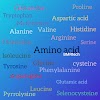Threonine | Definition | History | Structure | Function......
THREONINE AMINO ACID
Introduction :-
Threonine is
an essential amino acid. That is used in the biosynthesis of proteins. It contains an α-amino group and carboxyl group. A side chain containing
a hydroxyl group, making it a polar, uncharged amino acid. It
is essential in humans, meaning the
body cannot synthesize it. It must be obtained from the diet. Threonine is
synthesized from aspartate in bacteria such as E. coli. It is encoded by all the codons starting
AC (ACU, ACC, ACA, and ACG).
Properties :-
Chemical formula :- C4H9NO3
Molar mass :- 119.120 g·mol−1
Solubility in water :- (H2O, g/dl) 10.6(30°),14.1(52°),19.0(61°)
Acidity (pKa) :- 2.63 (carboxyl), 10.43 (amino)
Thermodynamic data :- Phase behaviour (solid–liquid–gas)
Structure-
Source-
Foods contain high threonine include cottage cheese, poultry, fish, meat, lentils, black turtle bean and sesame seeds.
Racemic threonine can be prepared from crotonic acid by
alpha-functionalization using mercury(II) acetate
Biosynthesis-
It is an essential amino acid, threonine is not
synthesized in humans It is present in proteins in the diet. Adult humans
require about 20 mg/kg body weight/day. In plants and microorganisms, threonine
is synthesized from aspartic acid via α-aspartyl-semialdehyde
and homoserine. Homoserine
undergoes O-phosphorylation; this phosphate ester undergoes hydrolysis concomitant with relocation of the
OH group.
Function-
Threonine is
used to treat various nervous system disorders including spinal spasticity,
multiple sclerosis.
It helps in
the synthesis of glycine and serine which, in their turn, assist in the
production of collagen, elastin, and muscle tissue.
Threonine also
helps alleviate symptoms of Multiple Sclerosis and muscle.
SUBSCRIBE FOR MORE INFORMATION........!








0 Comments